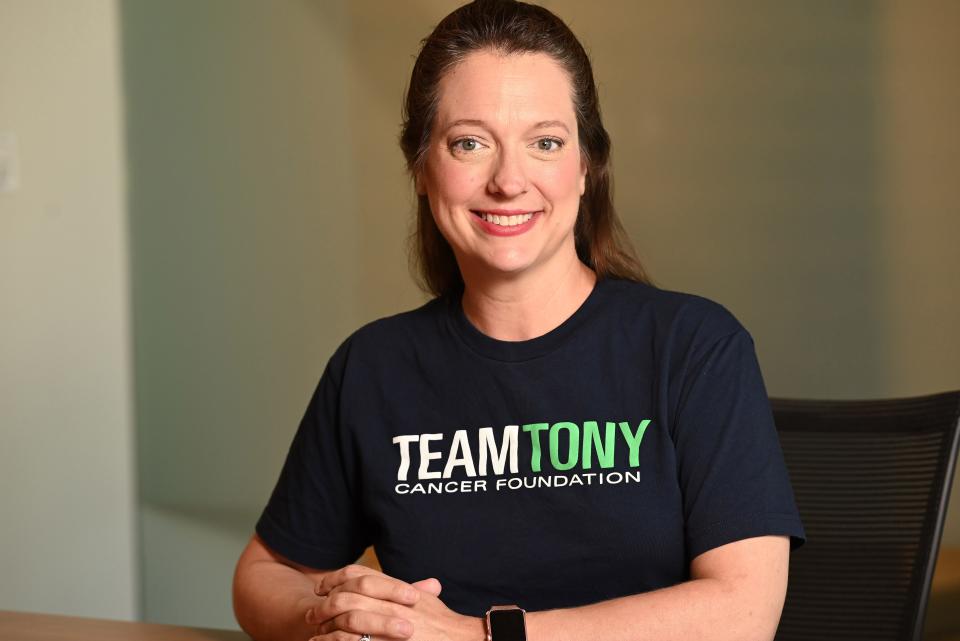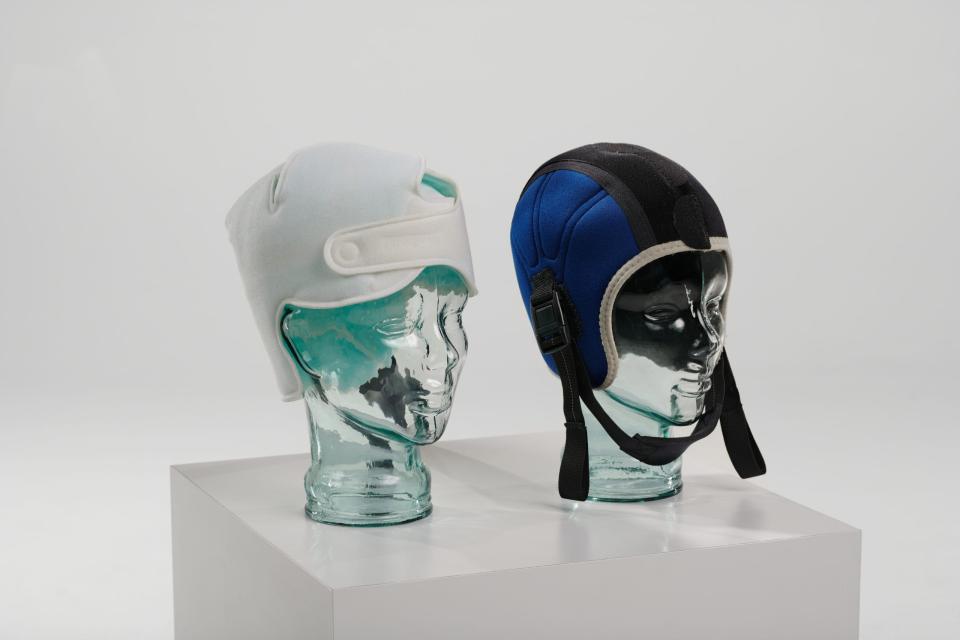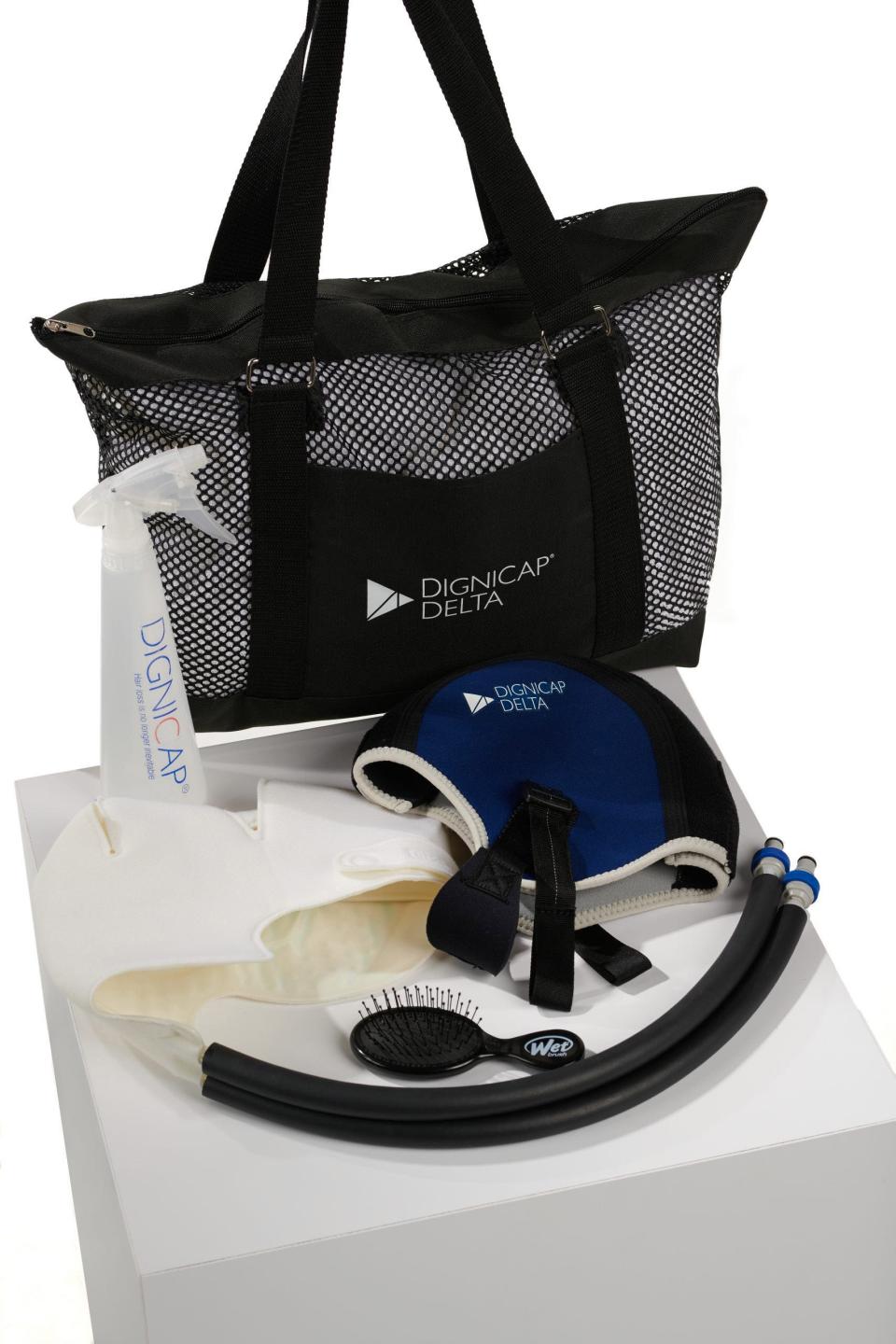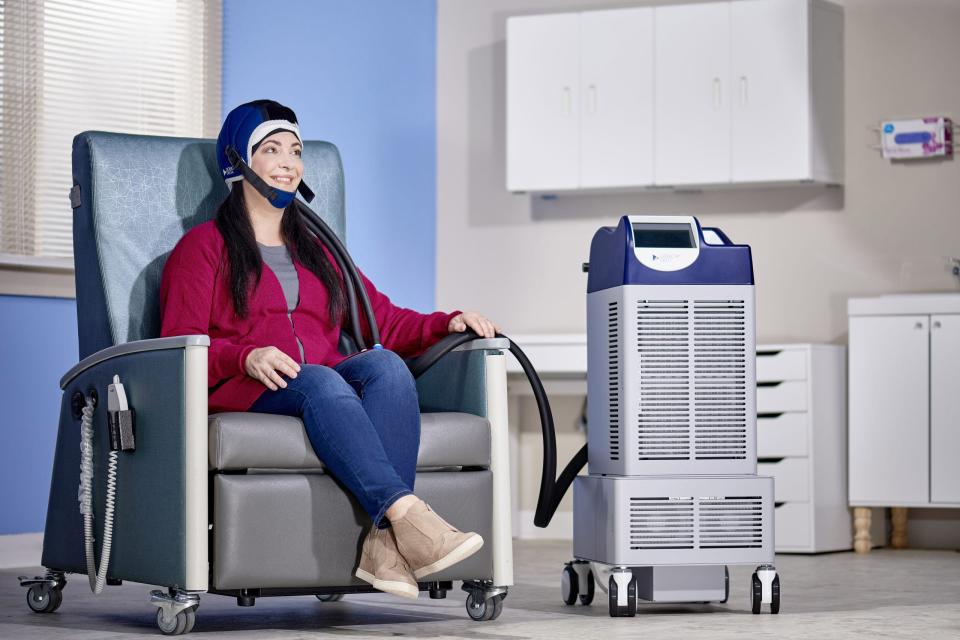After scalp cooling saved her hair in chemotherapy, Venice woman starts fund to help others
Clarification: Both the Dignitana and Paxman scalp cooling systems have FDA clearance. The FDA does not have an approval track for such devices. An earlier version of this story said otherwise.
VENICE – Shortly after Hollie Mowry learned she had breast cancer last July, she and her husband Tony took their daughters Cecelia and Snowden to the beach to break the news.
They explained that Hollie would be weaker from chemotherapy treatments and would lose her hair.
Tony Mowry said Cecilia, now 13, pretended to take it well, but Snowden, now 9, had lots of questions.
That was before the Mowrys learned about scalp cooling as a way to reduce the impact of chemotherapy drugs on hair follicles.
Related coverage: Breast cancer patients say 'cold capping' saved their hair
Read more: Vitale Gala raises record $11.1 million in fight against pediatric cancer

Mowry, who underwent treatments at the H. Lee Moffitt Cancer Center & Research Institute in Tampa, used the DigniCap scalp cooling system to help preserve her hair, while undergoing treatment sessions that lasted between six and eight hours.
Mowry went through six rounds of breast cancer chemotherapy – once every three weeks until Dec.2, 2021 – and wore the Dignitana-made cap each time.
“It’s not a lot of fun, but as you can see, I have all my hair,” she said.
“I lost 50% of it,” she added. “So it’s here and there and it’s growing back and it’s a little bit wonky.”

Since Tony is an attorney and Hollie works with the Gulf Coast Community Foundation, the couple could afford the therapy – which is generally not covered by insurance and can cost as much as $3,000.
“As soon as I got to the point of my cancer diagnosis where I knew I was probably going to survive, it became really important to me to help other cancer survivors,” she said. “I work for a nonprofit so my life is consumed with other people and people who are less fortunate and what can I do for them. And I just found it entirely unfair that I got to keep my hair because I could afford it and other women did not.”
Teaming with Tony
The couple contemplated fundraisers to help those who could not pay for hair-preservation treatment during chemotherapy.
“I saw the benefit of it both from her perspective, my perspective and our kids' perspective,” Tony Mowry said. “Until it’s covered by insurance, it’s something we felt that everybody should have a choice, like we did, to take advantage of it.”
In March, the perfect opportunity presented itself.
The owner at the couple’s favorite pub – Off-Trail Bike & Brew in Venice, needed someone to cover the bar, so he could fill in for the cook.
Tony, who tended bar while going to law school at Temple University in Philadelphia, agreed – providing any tips he made could go to their yet-to-be-established fund to help cancer patients.”
“We had not even contacted Team Tony when we decided to do this,” Tony Mowry recalled. “Hollie contacted them right away.
“We kind of built the airplane while it was flying that week,” he added.
The Team Tony Cancer Foundation, named for founder Tony McEachern, matches cancer patients with cancer survivors – fighters and survivors, as Executive Director Kelly Deam noted – for one-on-one mentorship. “So that they have someone who’s been through this journey that can be there to support them, answer questions about fears and emotions and all of the things that’s going on for them while they’re going through treatment,” she added.
As part of that outreach, Team Tony has a medical assistance fund that can help the cancer fighters defray costs for treatment.
In this case, funds raised by the Mowrys are earmarked for the scalp cooling therapy.
Tony Mowry tended bar from 3 to 8 p.m. on March 26 – something the couple promoted on social media – and let people who couldn’t make it know that they could donate to the effort online.
All donations were made through the Louis & Gloria Flanzer Trust program that matches individual donations up to $500, to essentially double the money.
“It was really busy, we raised pretty good money,” said Tony Mowry, who then jokingly added, “Which is not a good day to learn how to use a point-of-sale system.”
The Mowrys raised enough to cover treatments for two cancer patients. They’re planning additional fundraisers – including a 5K run using Off-Trail as a home base – and he may make the guest bartender appearance an annual fundraising event.
Hollie Mowry said she had two aims in starting the fund. One is to help people who can’t afford the hair-saving treatment and the second is to help increase the number of women undergoing the therapy, “so insurance companies can look at it and say, ‘This works, this improves mental health, maybe it improves cancer outcomes.’”
Low awareness and high cost
Nancy Marshall, one of the co-founders of the Rapunzel Project, said awareness and cost are the main impediments for more use of either cold cap therapy or scalp cooling systems to preserve hair during chemotherapy.
Marshall and Shirley Billigmeier founded the Rapunzel Project in 2009 to create awareness of both scalp cooling systems, as well as a variety of efforts to raise money to offset the cost of either therapy, which can be found at https://www.rapunzelproject.org.
There are a couple of national efforts, most notably https://www.hairtostay.org.
“I love to hear about these local initiatives, whether they’re big or small; every last one of them are welcome,” Marshall said, when told about the Mowrys establishing a fund with Team Tony.
Marshall noted several successful regional efforts but was especially ebullient about the effort of Cap and Conquer in Michigan, which was founded by six women.
The nonprofit, https://www.capandconquer.org raised raised more than $137,000 through a golf tournament last August.
“These six young women are just killing it,” Marshall said.
All these independent fundraising efforts are sorely needed.
While many insurance companies will readily cover the cost of a wig to mask hair loss, they have been slow to cover scalp cooling therapy, which emerged in the late 1990s with cold cap therapy.

Scalp cooling therapy works to prevent hair loss for men and women but is most often associated with women undergoing chemotherapy for breast cancer.
Kathy Robinson, a nurse manager with Florida Cancer Specialists in Sarasota, said she tells patients who use the DigniCap treatment there to “save every treatment you have and submit it to your insurance company. Some of those insurance companies are paying for it. You never know.”
Marshall said approval is very spotty and frequently involves appeals.
“Sometimes it might just depend on which adjuster you get,” she added. “You get somebody who had cancer and lost their hair and they’re sympathetic, somehow or another the claim gets approved.”
A decision for Medicare to cover some costs starting in 2022 created a gray area since Medicare will only reimburse the clinic where the chemotherapy is administered.
Meanwhile the typical billing process at clinics that use the two most prevalent scalp cooling systems – Dignitana and Paxman – has patients dealing directly with the manufacturers, though some clinics may also tack on an administration fee.
Dignitana and Paxman systems are used at many larger centers throughout Florida. Both systems have FDA clearance.
Patients who use the Dignitana system pay for no more than nine sessions – after that they’re free.
Paxman caps out-of-pocket costs for patients at $2,200.
The Rapunzel Project maintains a national list of where those systems are located as well as facilities that have medical grade freezers that can store cold caps.
Marshall says that cold caps – which can be stored and transported in dry ice – can be used at facilities that do not have medical grade freezers.
Locally both Moffitt and Florida Cancer Specialists are more-or-less removed from the scalp cooling payment process. Patients buy their initial cap kits from the provider and then buy treatment time on the machines directly from the provider.
Two methods, one goal
Patients who opt for the older cold cap system rent between four and eight caps from cap providers – Billigmeier and all of the Cap and Conquer founders all used Penguin Cold Caps – that are either kept cold in medical grade freezers or dry ice.
Cold cap patients must bring a friend or family member or pay an aide to help switch out the cold caps through the chemotherapy process, since the caps get warmer.
Typically, they’re changed out every 25 to 30 minutes.
Cold Caps typically start at -22 degrees Fahrenheit, which is -30 degrees Centigrade, and then warm gradually until they’re changed.
In contrast, scalp cooling machines keep the patient’s head at a constant temperature of 3 degrees Centigrade, or 37.4 degrees Fahrenheit.
For either process, the scalp cooling starts about 30 minutes before the chemotherapy begins.
Patients who use scalp cooling systems keep it on for about two hours after chemotherapy, as the drug is diluted.
Cold cap patients may wear their caps longer, since they can leave the infusion chair and wear their caps in the waiting room – or even the trip home.
Digntana touts a study that showed about 72% of its patients kept at least 50% of their hair.
Mayo Clinic – which uses the Paxman system – cites another study that found that 66% of patients who wore a cap cooled to 32 degrees experienced hair loss of 50% or less.
All of the patients in a control group that used no cooling system lost more than half of their hair.
Penguin Cold Caps cited a study in which 8 of 10 users retained more than 50% of their hair – but that was a small, 10-person study.
Cooling reduces blood flow
Amy Bucciarelli, clinical operations manager of the infusion and blood draw center at the McKinley Outpatient Center for Moffitt, said the cooling caps work, in part, because vasoconstriction in the scalp reduces blood flow.
“It reduces the amount of chemotherapy agent delivered to the hair follicles and then also by lowering the scalp temperature it reduces the reaction rate causing normal cellular activity localized to that scalp area. So it helps slow that dramatically.”
The McKinley campus was a beta test site for Dignitana.

“We’ve done more than 1,000 treatments here on our campus,” Bucciarelli said, adding that data gathered at Moffitt and other sites influenced the design of a new machine that came out in October 2019.
“I’ve been a nurse for 38 years and I’ve worked in oncology since the '80's,” Bucciarelli said. ”When we first started doing it, we used a tourniquet and a cold cap that was put in a refrigerator – literally.
“The technology is amazing because the coolant fluid moves throughout the cap, cools the cap to 3 degrees Centigrade.”
The cooling therapy works better with some drugs than others and is effective for solid tumors – breast cancer, gynecological cancers, prostate cancer – but not liquid ones and blood cancer.
Some patients can’t tolerate the cold, while others may have claustrophobia because of how the cap fits over the head and under the chin, Bucciarelli noted.
Robinson, the Florida Cancer Specialists nurse manager, noted that some patients are immediately dismayed with any hair loss during the process.
“It takes a lot of encouragement on our part to tell the patient it’s all about the regrowth,” Robinson said. “In the end, a couple weeks later, when they’ve done their treatment, they’re looking like Chia pets and they’re thanking us.
“We get good success with regrowth and that’s what you really need to coach people through,” she added. “You’re gonna have some air loss but it’s all about what happens afterwards, protecting those follicles.”
A way to maintain identity
The DigniCap Mowry wore at Moffitt includes a silicone inner cap and a neoprene outer cap . All must fit as tightly as possible and then are hooked into a hose to the cooling machine.
“It’s miserable, it’s not a fun experience,” Mowry said “They spray your hair down so that it’s absolutely soaking – so the back of your shirt is also soaking – and you’re cold already.
“The CSAs at Moffitt are the real heroes in this process, they’re the ones that are the most trained to do this,” Mowry said. “It’s really important that you get it on exactly right, otherwise it’s not going to hit all the right spots.
Sometimes aides had to place the cap more than once to get the right fit before it turns on.
Once that happens, “It’s like the worst ice-cream headache you ever had,” Mowry said. “You want it close to your scalp because you’re basically putting your scalp into hypothermia.”
“After a little while it goes numb and you can’t feel it anymore,” she added. “And then when they take it off, they have to wait. So they unplug it, turn it off and then they have to wait for it to thaw.”
Mowry, who is still undergoing cancer treatment but with a drug that does not require scalp cooling to preserve her hair, said most of her hair loss came around the edges of the cap and the crown of her head.
“It was not like a bald spot, it was just interspersed, so it didn’t look like I was losing my hair – unless you knew,” she said.
Rather than just accept hair loss and wear a wig, Mowry said she chose to include scalp cooling with her chemotherapy to preserve her identity.
“When you get diagnosed with cancer it takes over your life; everything revolves around it,” Mowry said. “It becomes your identity in a lot of ways, and it was just really important to me to not let that happen
“I didn't want to be: cancer patient,” she added. “I’m a mom, I'm a wife, I’m an employee, I’m a friend – I’m all those things, and I'm a cancer patient on the side.”
“It’s a piece of my life that I’m going to get through and be a cancer survivor.
“So I didn’t want to look in the mirror every single day and be reminded, ‘oh you have cancer, you have cancer, you have cancer.”
Meanwhile, the Mowrys wanted to keep things as normal as possible for Cecelia and Snowden.
Marshall, who did not need chemotherapy in her own bout with cancer, said the vast majority of people who choose to preserve their hair do so for the same reason as Mowry.
“It is so little about vanity. It’s much, much more about identity,” Marshall said. “It's looking like yourself, not looking like a sick person, it’s not seeing a stranger in the mirror.
“Very few patients tell us it's about vanity – it’s empowerment and it’s identity.
“When your hair falls out, it’s everybody’s business,” she added. “People feel entitled to offer you best wishes, advice, all kinds of stuff – but not every parent wants or needs that and they certainly would prefer to control from whom that comes.
“Having that control over whose business it is, I don’t know if you could even put a price on that.”
Earle Kimel primarily covers south Sarasota County for the Herald-Tribune and can be reached at earle.kimel@heraldtribune.com. Support local journalism with a digital subscription to the Herald-Tribune.
This article originally appeared on Sarasota Herald-Tribune: Woman starts fund to help others afford scalp cooling for chemotherapy

